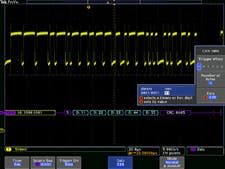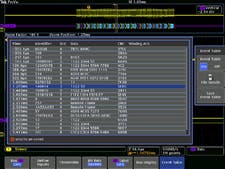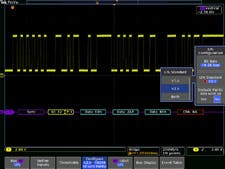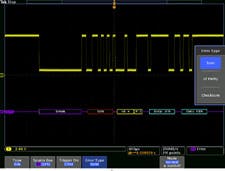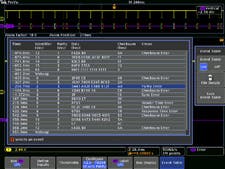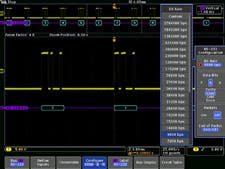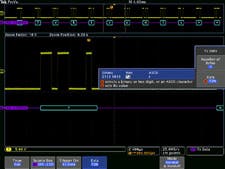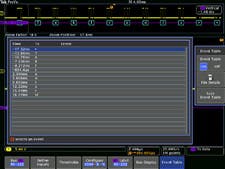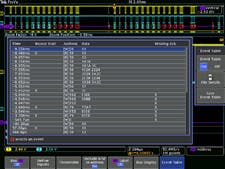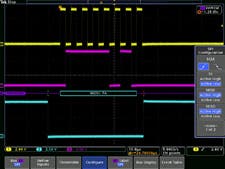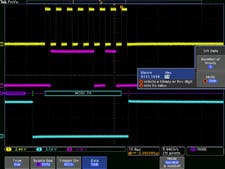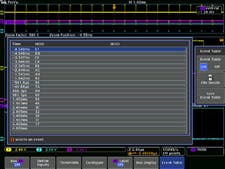Tektronix MDO3-BND
*Internal Option* Adds Application Bundle (MDO3AERO, MDO3AUDIO, MDO3AUTO, MDO3COMP, MDO3EMBD, MDO3FLEX, MDO3LMT, MDO3PWR, and MDO3USB) to MDO3000 Unit
Tektronix MDO3-BND
*Internal Option* Adds Application Bundle (MDO3AERO, MDO3AUDIO, MDO3AUTO, MDO3COMP, MDO3EMBD, MDO3FLEX, MDO3LMT, MDO3PWR, and MDO3USB) to MDO3000 Unit
- MDO3AERO:
- Automated serial triggering, decoding, and search options for MIL-STD-1553 and ARINC 429
- Trigger on all critical elements of serial buses
- MDO3AERO:
- Automated serial triggering, decoding, and search options for MIL-STD-1553 and ARINC 429
- Trigger on all critical elements of serial buses
- Decode all critical elements of each message (no more counting 1s and 0s)
- Search through long acquisitions using user-defined criteria to find specific messages
- Search mark table provides tabular view of events found during automated searches
- Export search mark table data to .csv files
- Event table shows decoded serial bus activity in tabular, timestamped format for quick summary of system activity
- Export event table data to .csv files
- For use with MDO3000 Series
- MDO3AUDIO:
- Automated serial triggering, decoding, and search options for I2S, LJ, RJ and TDM
- Trigger on all critical elements of serial buses
- Decode all critical elements of each message (no more counting 1s and 0s)
- Search through long acquisitions using user-defined criteria to find specific messages
- Search mark table provides tabular view of events found during automated searches
- Export search mark table data to .csv files
- Event table shows decoded serial bus activity in tabular, timestamped format for quick summary of system activity
- Export event table data to .csv files
- For use with Series MDO3000
- MDO3AUTO:
- Automated serial triggering, decoding, and search options for CAN, CAN FD and LIN
- Trigger on all critical elements of serial buses
- Decode all critical elements of each message (no more counting 1s and 0s)
- Search through long acquisitions using user-defined criteria to find specific messages
- Search mark table provides tabular view of events found during automated searches
- Export search mark table data to .csv files
- Event table shows decoded serial bus activity in tabular, timestamped format for quick summary of system activity
- Export event table data to .csv files
- For use with MDO3000C Series
- MDO3COMP:
- Automated serial triggering, decoding, and search options for RS-232, RS-422, RS-485 and UART
- Trigger on all critical elements of serial buses
- Decode all critical elements of each message (no more counting 1s and 0s)
- Search through long acquisitions using user-defined criteria to find specific messages
- Search mark table provides tabular view of events found during automated searches
- Export search mark table data to .csv files
- Event table shows decoded serial bus activity in tabular, timestamped format for quick summary of system activity
- Export event table data to .csv files
- For use with MDO3000 Series
- MDO3EMBD:
- Automated serial triggering, decoding, and search options for I2C and SPI
- Trigger on all critical elements of serial buses
- Decode all critical elements of each message (no more counting 1s and 0s)
- Search through long acquisitions using user-defined criteria to find specific messages
- Search mark table provides tabular view of events found during automated searches
- Export search mark table data to .csv files
- Event table shows decoded serial bus activity in tabular, timestamped format for quick summary of system activity
- Export event table data to .csv files
- For use with MDO3000 Series
- MDO3FLEX:
- Automated serial triggering, decoding, and search options for FlexRay
- Trigger on all critical elements of serial buses
- Decode all critical elements of each message (no more counting 1s and 0s)
- Search through long acquisitions using user-defined criteria to find specific messages
- Search mark table provides tabular view of events found during automated searches
- Export search mark table data to .csv files
- Event table shows decoded serial bus activity in tabular, timestamped format for quick summary of system activity
- Export event table data to .csv files
- For use with MDO3000 Series
- MDO3LMT:
- Conduct limit test Pass/Fail testing against "golden" waveform with tolerances
- Perform mask testing on ITU-T, ANSI T1.102, and USB standards
- Perform mask testing on custom user-defined masks
- Detailed test statistics provide insight into true signal behavior
- Customizable tests allow for multiple actions upon violations or test failures
- High waveform capture rates enable thousands of waveforms to be tested per second
- For use with MDO3000 Series
- MDO3PWR:
- Power loss measurements at switching device for improving switching power supply efficiency
- Automated ripple measurement setup eliminates manual processes
- Automated THD, true power, apparent power, power factor, and crest factor features eliminate tedious manual calculations
- Customizable safe operating area mask testing with linear and log scale for reliability testing
- Precompliance testing to the EN61000-3-2 Class A and MIL Standard 1399 Section 300A Standards reduces compliance test time and risk
- Modulation analysis quickly provides accurate active power factor characterization
- Deskew wizard ensures accurate, time-correlated results
- Correct scale factor and unit display while using third-party current probes eliminates manual calculations and human error
- Applications
- Power loss measurement at switching device
- Characterization of power semiconductor devices
- Optimal drive characterization of synchronous rectifiers
- Measurement and analysis of ripple and noise
- Precompliance testing to IEC standard EN61000 3-2 Class A, MIL Standard 1399 Section 300A, and up to 400 harmonics
- Debugging active power factor correction circuits
- For use with MSO/DPO3000 Series
- MDO3USB:
- Automated serial triggering, decoding, and search options for USB, LS and FS
- Trigger on all critical elements of serial buses
- Decode all critical elements of each message (no more counting 1s and 0s)
- Search through long acquisitions using user-defined criteria to find specific messages
- Search mark table provides tabular view of events found during automated searches
- Export search mark table data to .csv files
- Event table shows decoded serial bus activity in tabular, timestamped format for quick summary of system activity
- Export event table data to .csv files
- For use with MDO3000 Series
The Tektronix MDO3BND Application Module Bundle for MDO3000 Series enables triggering on packet-level information on MIL-STD-1553 and ARINC 429 buses (MDO3AERO Module); I2S, LJ, RJ and TDM audio buses (MDO3AUDIO Module); CAN, CAN FD, and LIN buses (MDO3AUTO Module); RS-232, RS-422, RS-485, and UART buses (MDO3COMP Module); I2C and SPI buses (MDO3EMBD Module); FlexRay buses (MDO3FLEX Module); and for low-speed, and full-speed USB serial buses (MDO3USB Mdoules); it enables testing against limit masks generated from "golden" waveforms and mask testing using custom user-defined masks (MDO3LMT Module); and it allows an embedded designer who rarely deals with power measurements to quickly get the same accurate, repeatable results as a power supply expert (MDO3PWR Module); as well as analytical tools such as digital views of the signal, bus views, packet decoding, search tools, and packet decode tables with time-stamp information.
Bus Display
Provide a higher-level, combined view of the individual signals (clock, data, chip enable, etc.) that make up your bus, making it easy to identify where packets begin and end and identifying sub-packet components such as address, data, identifier, CRC, etc.
Bus Decoding
Once you have set up a bus, the oscilloscope will decode each packet on the bus, and display the value in hex, binary, and decimal.
Search
Serial triggering is very useful for isolating the event of interest. In the past, users had to manually scroll through the waveform counting and converting bits and looking for what caused the event. With a Serial Application module, you can enable the oscilloscope to automatically search through the acquired data for user-defined criteria including serial packet content. Each occurrence is highlighted by a search mark. Rapid navigation between marks is as simple as pressing the Previous and Next buttons on the oscilloscope front panel. The Search Mark table provides a tabular view of all events found during an automated search. The search mark data can be exported to a .csv file.
Event Table
In addition to seeing decoded packet data on the bus waveform itself, you can view all captured packets in a tabular view much like you would see in a software listing. Packets are time stamped and listed consecutively with columns for each component (Address, Data, etc.).
MDO3AERO:
The Tektronix MDO3AERO Aerospace Serial Triggering and Analysis Module for MDO3000 Series (MIL-STD-1553, ARINC 429) enables triggering on packet-level information on MIL-STD-1553 and ARINC 429 buses, as well as analytical tools, such as digital views of the signal, bus views, packet decoding, search tools, and packet decode tables with time-stamp information.
Application modules have licenses which can be transferred between an application module and an oscilloscope. The Tektronix MDO3AERO's license may be contained in the module; it can be moved from one instrument to another. Or, the license can be contained in the oscilloscope, allowing the module to be removed and stored for safekeeping. The license can also be transferred back to the module for use in another MDO3000 oscilloscope. Transferring the license to an oscilloscope and removing the Tektronix MDO3AERO module permits the simultaneous use of more than two applications.
Serial Triggering and Analysis Application Modules
On a serial bus, a single signal often includes address, control, data, and clock information. This can make isolating events of interest difficult. The Serial Application modules for the MDO3000 Series transform the oscilloscope into a robust tool for debugging serial buses with automatic trigger, decode, and search for MIL-STD-1553 and ARINC 429.
Serial Triggering
Trigger on packet content such as start of packet, specific addresses, specific data content, unique identifiers, etc. on MIL-STD-1553 and ARINC 429 serial interfaces.
MIL-STD-1553 Characteristics:
- Bus setup options:
- Sources:
- Analog channels 1-4
- Reference waveforms 1-4
- Math waveform
- Thresholds: High and low threshold per source
- Recommended probing: Single ended or differential (only one single-ended signal required)
- Decode configuration:
- Bit rate: 1 Mb/s per the standard
- Response time: 2 μs - 100 μs
- Polarity: Normal or inverted
- Decode formats available: Mixed1: Hex (data), Decimal (addresses and count), Binary (bits) Mixed2: ASCII (data), Decimal (addresses and count), Binary (bits) Block Hex Hex and Binary Binary
- Display modes:
- Bus: Bus only
- Bus and waveforms: Simultaneous display of bus and logic waveforms
- Event table: Decoded packet data in a tabular view
- Sources:
- Bus trigger and search options:
- Trigger and/or search on:
- Sync
- Word type 2 (command, status, data)
- Command word 2 (set RT address (=, ≠, <, >, ≤, ≥, inside range, outside range), T/R, sub-address/mode, data word count/mode code, and parity individually)
- Status word 2 (set RT address (=, ≠, <, >, ≤, ≥, inside range, outside range), message error, instrumentation, service request bit, broadcast command received, busy, subsystem flag, dynamic bus control acceptance (DBCA), terminal flag, and parity individually)
- Data word (user-specified 16-bit data value)
- Error (sync, parity, manchester, non-contiguous data)
- Idle time (minimum time selectable from 4 μs to 100 μs; maximum time selectable from 12 μs to 100 μs; trigger on < minimum, > maximum, inside range, outside range)
- Maximum clock/data rate: Up to 1 Mb/s (for automated decoding of bus)
- Decode display:
- Start (green bracket)
- Sync 3 (purple box) with word type identified
- Address (yellow box)
- R/T (purple box)
- Word count (purple box)
- Status bits (purple box)
- Data (cyan box)
- Parity (purple box)
- Stop (red bracket)
- Errors (red box)
- Trigger and/or search on:
MDO3AUDIO:
The Tektronix MDO3AUDIO Audio Serial Triggering and Analysis Module for MDO3000 Series (I2S, LJ, RJ, TDM) enables triggering on packet-level information on I2S, LJ, RJ and TDM audio buses as well as analytical tools such as digital views of the signal, bus views, packet decoding, search tools, and packet decode tables with time-stamp information.
Application modules have licenses which can be transferred between an application module and an oscilloscope. The Tektronix MDO3AUDIO's license maybe contained in the module; it can be moved from one instrument to another. Or, the license can be contained in the oscilloscope, allowing the module to be removed and stored for safekeeping. The license can also be transferred back to the module for use in another MDO3000 oscilloscope. Transferring the license to an oscilloscope and removing the Tektronix MDO3AUDIO module permits the silmultaneous use of more than two applications.
Serial Triggering and Analysis Application Modules
On a serial bus, a single signal often includes address, control, data, and clock information. This can make isolating events of interest difficult. The Serial Application modules for the MDO3000 Series transform the oscilloscope into a robust tool for debugging serial buses with automatic trigger, decode, and search for I2S, LJ, RJ and TDM.
Serial Triggering
Trigger on packet content such as start of packet, specific addresses, specific data content, unique identifiers, etc. on I2S, LJ, RJ and TDM serial interfaces.
I2S/LJ/RJ/TDM Characteristics:
- Bus setup options:
- Sources (clock and data):
- Analog channels 1-4
- Digital channels D0-D15
- Thresholds: Per-channel thresholds
- Recommended probing: Single ended
- Decode configuration:
- Word size: 4-32 bits
- Clock: Rising or falling edge
- Word select polarity: Normal or inverted
- Data high: 1 or 0
- Bit order:
- Most significant (MS) first
- Least significant (LS) first
- Decode formats available: Signed decimal, hex, binary
- Display modes:
- Bus: Bus only
- Bus and waveforms: Simultaneous display of bus and logic waveforms
- Event table: Decoded packet data in a tabular view
- Sources (clock and data):
- Bus trigger and search options:
- Trigger and/or search on:
- Word select
- Frame sync
- Data (select either word, left word, or right word; trigger or search when =, ≠,<,>, ≤, ≥, inside range, outside range)
- Trigger and/or search on:
- Bus decode:
- Maximum clock/data rate:
- Up to 12.5 Mb/s (for automated decoding of I2S/LJ/RJ bus)
- Up to 25 Mb/s (for automated decoding of TDM bus)
- Decode display:
- Start (green bracket)
- Data (cyan box)
- Stop (red bracket)
- Maximum clock/data rate:
MDO3AUTO:
The Tektronix MDO3AUTO Automotive Serial Triggering and Analysis Module for MDO3000 Series (CAN, CAN FD, LIN) enables triggering on packet-level information on CAN, CAN FD, and LIN buses, as well as analytical tools, such as digital views of the signal, bus views, packet decoding, search tools, and packet decode tables with time-stamp information.
Application modules have licenses which can be transferred between an application module and an oscilloscope. The Tektronix MDO3AUTO's license may be contained in the module; it can be moved from one instrument to another. Or, the license can be contained in the oscilloscope, allowing the module to be removed and stored for safekeeping. The license can also be transferred back to the module for use in another MDO3000 oscilloscope. Transferring the license to an oscilloscope and removing the Tektronix MDO3AUTO module permits the simultaneous use of more than two applications.
Serial Triggering and Analysis Application Modules
On a serial bus, a single signal often includes address, control, data, and clock information. This can make isolating events of interest difficult. The Serial Application modules for the MDO3000 Series transform the oscilloscope into a robust tool for debugging serial buses with automatic trigger, decode, and search for CAN, CAN FD, and LIN.
Serial Triggering
Trigger on packet content such as start of packet, specific addresses, specific data content, unique identifiers, etc. on CAN, CAN FD, and LIN serial interfaces.
CAN, CAN FD (ISO and non-ISO) Characteristics:
- Bus setup options:
- Source for CAN_H, CAN_L, Rx, or Tx probing:
- Analog channels 1-4
- Digital channels D0-D15
- Source for differential probing: Analog channels 1-4
- Thresholds: Per-channel thresholds
- Recommended probing:
- TDP1500 differential probe
- CAN_H, CAN_L, Rx, Tx: Single ended
- Differential: Differential
- Bit rate:
- Standard - Pre-defined list of rates and Custom: 10 Kb/s - 1 Mb/s
- FD - Pre-defined and custom: 1 Mb/s - 10 Mb/s (7 M/bs MDO3K)
- Sample point: Position at 15% to 95% within bit period or unit interval
- Decode formats available: Hex, binary
- Display modes:
- Bus: Bus only
- Bus and waveforms: Simultaneous display of bus and logic waveforms
- Event table: Decoded packet data in a tabular view
- Source for CAN_H, CAN_L, Rx, or Tx probing:
- Bus trigger and search options:
- Trigger and/or search on:
- Start of frame
- Type of frame (data, remote, error, overload)
- Identifier (standard or extended)
- Data (number of bytes 1-8, trigger or search when =, ≠, <, >, ≤, ≥)
- Identifier and data
- End of frame
- Missing ack
- Bit stuffing error
- FD BRS bit
- FD ESI bit
- Form error
- Any error
- Trigger and/or search on:
- Bus decode:
- Decode display:
- Start (green bracket)
- Address (yellow box)
- DLC, CRC (purple box)
- Missing ack (red ! symbol)
- Data (cyan box)
- Stop (red bracket)
- Bit stuffing errors (red box)
- Decode display:
LIN Characteristics:
- Bus setup options:
- Source:
- Analog channels 1-4
- Digital channels D0-D15
- Thresholds: Per-channel thresholds
- Recommended probing: Single ended
- Decode configuration:
- Polarity: Normal or inverted
- Bit rate:
- Pre-defined list of rates: 1.2 kb/s - 19.2 kb/s
- Custom: 800 b/s - 100 kb/s
- LIN standard: v1.x, v2.x, or both
- Include parity bits with ID: Yes or no
- Decode formats available Mixed: ID and Parity are shown in Hex, Data and Checksum are shown in Binary Hex: all fields Binary: all fields
- Display modes:
- Bus: Bus only
- Bus and waveforms: Simultaneous display of bus and logic waveforms
- Event table: Decoded packet data in a tabular view
- Source:
- Bus trigger and search options:
- Trigger and/or search on:
- Sync
- Identifier
- Data (number of bytes 1-8; trigger or search when =, ≠, <, >, ≤, ≥, inside range, outside range)
- Identifier and data
- Wakeup frame
- Sleep frame
- Error (sync, ID parity, checksum)
- Trigger and/or search on:
- Bus decode:
- Maximum bit rate: Up to 1 Mb/s, by LIN definition up to 20 kb/s (for automated decoding of bus)
- Decode display:
- Start (green bracket)
- Sync, break (purple box)
- Identifier, parity (yellow box)
- Data (cyan box)
- Checksum, wakeup (purple box)
- End of frame (red bracket)
- Errors (red box)
- - Sync
- - Parity
- - Checksum
- - Header time
- - Response time
- - Frame time
- - Response and frame time
MDO3COMP:
The Tektronix MDO3COMP Computer Serial Triggering and Analysis Module for MDO3000 Series (RS-232, RS-422, RS-485, UART) enables triggering on packet-level information on RS-232, RS-422, RS-485, and UART buses as well as analytical tools such as digital views of the signal, bus views, packet decoding, search tools, and packet decode tables with time-stamp information.
Application modules have licenses which can be transferred between an application module and an oscilloscope. The Tektronix MDO3COMP's license maybe contained in the module; it can to be moved from one instrument to another. Or, the license can be contained in the oscilloscope, allowing the module to be removed and stored for safekeeping. The license can also be transferred back to the module for use in another MDO3000 oscilloscope. Transferring the license to an oscilloscope and removing the Tektronix MDO3COMP module permits the simpultaneous use of more than two applications.
Serial Triggering and Analysis Application Modules
On a serial bus, a single signal often includes address, control, data, and clock information. This can make isolating events of interest difficult. The Serial Application modules for the MDO3000 Series transform the oscilloscope into a robust tool for debugging serial buses with automatic trigger, decode, and search for RS-232, RS-422, RS-485, and UART.
Serial Triggering
Trigger on packet content such as start of packet, specific addresses, specific data content, unique identifiers, etc. on RS-232, RS-422, RS-485, and UART serial interfaces.
RS-232/UART/RS-422/RS-485 Characteristics:
- Bus setup options:
- RS-232/UART sources (transmit and receive):
- Analog channels 1-4
- Digital channels D0-D15
- RS-422/RS-485 sources (transmit and receive): Analog channels 1-4
- Thresholds: Per-channel thresholds
- Recommended probing: RS-232/UART: Single ended RS-422/RS-485: Differential
- Polarity: RS-422/RS-485 Inverted (UART, RS-422/RS-485)
- Decode configuration:
- Bit rate:
- Pre-defined list of rates: 50 b/s - 2.8 Mb/s
- Custom: 50 b/s - 10 Mb/s
- Data bits: 7, 8, or 9
- Parity: None, odd, or even
- Packets: On or off
- End of packet:
- 00h (NUL)
- 0Ah (LF)
- 0Dh (CR)
- 20h (SP)
- FFh
- Bit rate:
- Decode formats available: Hex, binary, ASCII
- Display modes:
- Bus: Bus only
- Bus and waveforms: Simultaneous display of bus and logic waveforms
- Event table Decoded packet data in a tabular view
- RS-232/UART sources (transmit and receive):
- Bus trigger and search options:
- Trigger and/or search on:
- Tx start bit
- Rx start bit
- Tx end of packet
- Rx end of packet
- Tx data (number of bytes 1-10)
- Rx data (number of bytes 1-10)
- Tx parity error
- Rx parity error
- Trigger and/or search on:
- Bus decode:
- Maximum Clock/Data Rate: Up to 10 Mb/s (for automated decoding of bus)
- Decode display:
- Data (cyan box)
- Errors (red box)
- - Parity
- - Framing
MDO3EMBD:
The Tektronix MDO3EMBD Embedded Serial Triggering and Analysis Module for MDO3000 Series (I2C, SPI) enables triggering on packet-level information on I2C and SPI buses as well as analytical tools such as digital views of the signal, bus views, packet decoding, search tools, and packet decode tables with time-stamp information.
Application modules have licenses which can be transferred between an application module and an oscilloscope. The Tektronix MDO3EMBD's license maybe contained in the module; it can be moved from one instrument to another. Or, the license can be contained in the oscilloscope, allowing the module to be removed and stored for safekeeping. The license can also be transferred back to the module for use in another MDO3000 oscilloscope. Transferring the license to an oscilloscope and removing the Tektronix MDO3EMBD module permits the simultaneous use of more than two applications.
Serial Triggering and Analysis Application Modules
On a serial bus, a single signal often includes address, control, data, and clock information. This can make isolating events of interest difficult. The Serial Application modules for the MDO3000 Series transform the oscilloscope into a robust tool for debugging serial buses with automatic trigger, decode, and search for I2C and SPI.
Serial Triggering
Trigger on packet content such as start of packet, specific addresses, specific data content, unique identifiers, etc. on I2C and SPI serial interfaces.
I2C Characteristics:
- Bus setup options:
- Sources (clock and data):
- Analog channels 1-4
- Digital channels D0-D15
- Thresholds: Per-channel thresholds
- Recommended probing: Single ended
- Include R/W in address: Yes or no
- Decode formats available: Hex, binary
- Display modes:
- Bus: Bus only
- Bus and waveforms: Simultaneous display of bus and logic waveforms
- Event table: Decoded packet data in a tabular view
- Sources (clock and data):
- Bus trigger and search options:
- Trigger and/or search on:
- Start
- Stop
- Repeated start
- Missing ack
- Address (7 or 10 bit) with R/W selection
- Data (number of bytes 1-5)
- Address and data
- Trigger and/or search on:
- Bus decode:
- Maximum clock/data rate: Up to 10 Mb/s (for automated decoding of bus)
- Decode display:
- Start (green bracket)
- Address (yellow box)
- Missing ack (red ! symbol)
- Data (cyan box)
- Stop (red bracket)
SPI Characteristics:
- Bus setup options:
- Sources (clock, slave select, MOSI, and MISO):
- Analog channels 1-4
- Digital channels D0-D15
- Thresholds: Per-channel thresholds
- Recommended probing: Single ended
- Decode configuration:
- Framing:
- Idle time (2-wire SPI)
- Slave select (3-wire or 4-wire SPI)
- Clock: Rising or falling edge
- Slave select: Active high or active low
- MOSI: Active high or active low
- MISO: Active high or active low
- Word size: 4-32 bits
- Bit order:
- Most Significant (MS) first
- Least Significant (LS) first
- Framing:
- Decode formats available: Hex, binary
- Display modes:
- Bus: Bus only
- Bus and waveforms: Simultaneous display of bus and logic waveforms
- Event table: Decoded packet data in a tabular view
- Sources (clock, slave select, MOSI, and MISO):
- Bus trigger and search options:
- Trigger and/or search on:
- SS active
- Start of frame
- MOSI
- MISO
- MOSI and MISO
- Data: maximum of 128 bits (up to four 32-bit words or 32 four-bit words)
- Trigger and/or search on:
- Bus decode:
- Maximum clock/data rate: Up to 50 Mb/s (for automated decoding of bus)
- Decode display:
- Start (green bracket)
- Data (cyan box)
- Stop (red bracket)
MDO3FLEX:
The Tektronix MDO3FLEX FlexRay Serial Triggering and Analysis Module for MDO3000 Series (FlexRay) enables triggering on packet-level information on FlexRay buses as well as analytical tools such as digital views of the signal, bus views, packet decoding, search tools, and packet decode tables with time-stamp information.
Application modules have licenses which can be transferred between an application module and an oscilloscope. The Tektronix MDO3FLEX's license maybe contained in the module; it can to be moved from one instrument to another. Or, the license can be contained in the oscilloscope, allowing the module to be removed and stored for safekeeping. The license can also be transferred back to the module for use in another MDO3000 oscilloscope. Transferring the license to an oscilloscope and removing the Tektronix MDO3FLEX module permits the simpultaneous use of more than two applications.
| Country of Origin | China |
|---|---|
| Brand | Tektronix |
| Condition | NEW |
- 1 - Aerospace Serial Triggering and Analysis Module for MDO3000 Series (MDO3AERO)
- 1 - Audio Serial Triggering and Analysis Module for MDO3000 Series (MDO3AUDIO)
- 1 - Automotive Serial Triggering and Analysis Module for MDO3000 Series (MDO3AUTO)
- 1 - Computer Serial Triggering and Analysis Module for MDO3000 Series (MDO3COMP)
- 1 - Embedded Serial Triggering and Analysis Module for MDO3000 Series (MDO3EMBD)
- 1 - FlexRay Serial Triggering and Analysis Module for MDO3000 Series (MDO3FLEX)
- 1 - Limit and Mask Test Application Module for MDO3000 Series (MDO3LMT)
- 1 - Power Analysis Application Module for MDO3000 Series (MDO3PWR)
- 1 - USB Serial Triggering and Analysis Module for MDO3000 Series (MDO3USB)









